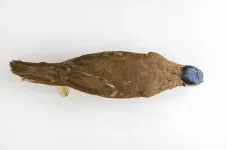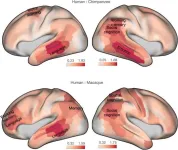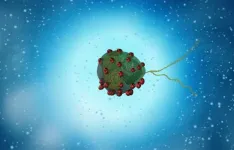(Press-News.org) On first inspection, the Cuban blue-headed quail dove doesn’t look like much: drab brown feathers, a slender beak, a pronounced strut in their walk typical of most other doves. You’d be forgiven for overlooking it in favor of Cuba’s prismatic parrots. But looks aren’t everything. For decades, this unassuming bird has perplexed biologists, who have no idea where it came from, how it got to the island or what it’s related to.
Now, for the first time, scientists have sequenced DNA from the blue-headed quail dove with the goal of finally getting to the bottom of things. Instead, they’re even more perplexed now than when they started.
“This species has been an ornithological enigma for a very long time,” said Jessica Oswald, a Florida Museum of Natural History consultant staff affiliate and lead author of a study describing the results of the DNA analysis. “We focused on this dove species because we were anticipating an odd result that may help us understand the complex biogeography of the Caribbean. We did not anticipate it being so unique from an evolutionary perspective relative to anything else.”
Blue-headed quail doves were once assumed to be most closely related to the doves and pigeons of Central and South America. But keen biologists began noticing it had several unusual features that are more similar to the doves and pigeons of Australasia.
The study, published in the journal Biology Letters, shows that neither of these assumptions are accurate. Blue-headed quail doves aren’t closely related to species in Australia, but they don’t share a close relationship with American doves either.
“This species is even more evolutionarily distinct than the dodo was,” Oswald said. The dodo was surprisingly also a type of dove, and it had at least one close relative that we know of, the Rodrigues solitaire, which is now also extinct.
No one knows how old the dove family is, but an analysis of DNA combined with the age of several pigeon fossils in this study suggests that the blue-headed quail may have originated as far back as 50 million years ago. Even for evolutionary biologists, whose concept of time is better measured by the formation of mountains than by a 12-hour clock, this is old. The lineages that gave rise to humans and chimpanzees parted ways just a short 5 to 6 million years ago.
Ancient DNA illuminates the murky history of Caribbean extinctions
Oswald conducted the research while working as a postdoctoral fellow at the Florida Museum. The study was part of a broader initiative funded by the National Science Foundation to discover the causes of bird extinction in the Caribbean over the last several thousand years.
An estimated 12% of all Caribbean birds have gone extinct since the arrival of humans on the islands, among them a giant owl that stood nearly four feet tall, more than a dozen parrots, a raptor up to 30% larger than bald eagles, a flightless ibis that used its stubby wings like clubs to bludgeon animals during combat, and a condor with a tangled mass of sinew and muscle wrapped around its skull that gave it a stronger bite than the condors around today.
With only the fossils to go on, scientists have often found it difficult to determine how the Caribbean’s extinct species are related to modern ones.
So Oswald developed techniques to extract and sequence ancient DNA from Caribbean bird fossils. In an early proof of concept using the fossils of an extinct Caribbean cave rail, she and her colleagues discovered the first — albeit extinct — Caribbean bird whose closest relatives are in Africa, New Guinea and New Zealand. In a follow-up study, they used the same techniques to show that a parrot that is now restricted to the island of Hispaniola once had a much broader distribution in the Caribbean before humans showed up.
The blue-headed quail dove isn’t extinct yet but may be on its way there.
“There are 1,000 mature individuals of this species left in Cuba. It is threatened by overhunting by people, habitat loss and invasive species like cats. It’s very much on the brink,” Oswald said.
No one had ever successfully sequenced DNA from this species to figure out what it was, primarily because the bird is so rare. The few specimens that exist in North American museums were collected several decades ago, making it difficult to extract DNA from them with the typical methods used for fresh tissue.
Oswald tried her newly devised technique for sequencing ancient DNA on a toe pad clipped from a blue-headed quail dove specimen collected in 1958 and curated at the Florida Museum. It was unclear whether the method she’d originally designed with fossils in mind would work with preserved tissue, and she spent a tense few days awaiting the results. When they came, she contacted her colleague and former doctoral adviser to give him the news.
“She called me up and said, ‘Are you sitting down?’ I thought she was going to tell me they didn’t get any good sequencing and had no data, but it was just the opposite,” said study co-author David Steadman, who worked as curator of ornithology at the Florida Museum from 1995 to 2021. During his tenure, Steadman witnessed the ongoing technological explosion that furnished the sciences with advanced tools for studying natural history.
“It’s another instance of the importance of museums and the long-term maintenance of specimens. As ancient DNA techniques have improved, we find that fossils, historical and modern specimens are even more useful than before.”
Oswald and Steadman were both surprised by what the DNA had to tell them. There are other doves from the Caribbean. This includes an extinct species that scientists know about only because they have found their bones in archaeological sites where people once discarded their trash, a sure sign it was a staple of Indigenous diets before it died out. But there’s little doubt that all other doves in the Caribbean flew there from North, Central or South America, where their closest relatives are living today.
The blue-headed quail dove could have come from anywhere.
“It’s a relictual species and has probably been in the Caribbean for a long time. Cuba is an old island,” Steadman said.
Where it came from before that is anyone’s guess. Either it represents the last remaining scion of a once diverse and widespread dynasty of birds — as the genetics seem to suggest — or it’s a strange offshoot of other living doves that just happened to get stranded on Cuba when the world was a little younger.
Though the blue-headed quail dove prefers to spend most of its time on the ground, its ancestors almost certainly possessed the powerful flying ability of most other doves and pigeons, which they’ve used to spread out far and wide.
“There are some groups of birds that are spectacular dispersers, one being pigeons and doves. They just get up and go,” Oswald said. “Many are particularly good dispersers because they eat a lot of fruit and sometimes have to move large distances to look for fruiting trees.”
Bret Boyd of the Virginia Commonwealth University, Avery Szewczak and Julie Allen of Virginia Tech, Michelle LeFebvre and Rob Guralnick of the Florida Museum of Natural History and Brian Stucky of the University of Florida are also co-authors of the study.
END
Unique dove species is the dodo of the Caribbean and in similar danger of dying out
2025-03-17
ELSE PRESS RELEASES FROM THIS DATE:
Free University Brussels (VUB) opens its doors to censored American researchers
2025-03-17
The Vrije Universiteit Brussel (VUB) is opening 12 postdoctoral positions for international researchers, with a specific focus on American scholars working in socially significant fields. These prestigious fellowships come with substantial funding (€2.5 million) as part of the European Marie Skłodowska-Curie (MSCA) program. Additionally, as part of the Brains for Brussels initiative, VUB aims to actively attract American professors looking to relocate. In collaboration with its Francophone sister university ULB, VUB is also providing 18 apartments for international ...
Neuroanatomy that sets humans apart from other primates
2025-03-17
Researchers have widely accepted that what sets humans apart from nonhuman primates are prefrontal cortex–driven behaviors such as decision-making, reasoning, planning, and attention. In a new JNeurosci paper, research led by Rogier Mars, at University of Oxford, and Katherine Bryant, at Aix-Marseille University, provides a better picture of the cortical evolution that distinguishes human brains from other primates.
The researchers compared cortical organization not only between humans and macaques, which is a standard for human and nonhuman primate ...
Stress and sex influence traumatic brain injury outcomes
2025-03-17
How stress impacts behavioral outcomes of traumatic brain injury (TBI) represents a major gap in knowledge. This oversight is especially felt by those in the military due to the high prevalence of TBI and the abundance of stress that they endure. In a study funded by the US Department of Defense, researchers led by Pamela VandeVord at Virginia Tech discovered that prior stress exposure influences TBI outcomes in a sex-dependent manner.
In their eNeuro paper, VandeVord and colleagues used an unpredictable stress paradigm ...
Study: suppressing key protein may unlock immunotherapy for Glioblastoma
2025-03-17
MIAMI, FLORIDA (EMBARGOED UNTIL MARCH 17, 2025, AT NOON EDT) – Glioblastoma has remained one of the toughest cancers to treat, resisting even the latest advances in immunotherapy. But new research from Sylvester Comprehensive Cancer Center, part of the University of Miami Miller School of Medicine, suggests a way forward: suppressing a protein called ZNF638 triggers an antiviral immune response, making immune checkpoint inhibitors more effective. The discovery not only offers a potential new treatment strategy but also identifies ...
Early surgical intervention in children with sleep-disordered breathing reduces need for doctor visits, prescriptions
2025-03-17
In a randomized trial, Mass General Brigham researchers found the surgical removal of tonsils and adenoids was effective for children with snoring and mild sleep apnea
An estimated 6 to 17 percent of children have sleep-disordered breathing, ranging from snoring to sleep apnea, which can cause behavioral, neurocognitive, cardiovascular, and cardiometabolic issues. A new study from Mass General Brigham researchers reveals that adenotonsillectomy—the surgical removal of tonsils and adenoids—is an effective early intervention for these children. Their results are published in JAMA Pediatrics.
“To ...
Statin use and risk of hepatocellular carcinoma and liver fibrosis in chronic liver disease
2025-03-17
About The Study: This cohort study found that statin use was associated with a reduced risk of hepatocellular carcinoma and hepatic decompensation in patients with chronic liver disease. These findings provide support for the potential role of statins in prevention of hepatocellular carcinoma and liver disease progression.
Corresponding Authors: To contact the corresponding authors, email Jonggi Choi, MD, PhD, (j.choi@amc.seoul.kr) and Raymond T. Chung, MD, (chung.raymond@mgh.harvard.edu).
To ...
Gender-affirming hormone therapy and depressive symptoms among transgender adults
2025-03-17
About The Study: In this longitudinal observational cohort study, gender-affirming hormone therapy was associated with lower rates of moderate-to-severe depressive symptoms, highlighting the importance of gender-affirming primary care models for transgender, nonbinary, and gender diverse patients.
Corresponding Author: To contact the corresponding author, Sari L. Reisner, ScD, MA, email sreisner@umich.edu.
To access the embargoed study: Visit our For The Media website at this link https://media.jamanetwork.com/
(doi:10.1001/jamanetworkopen.2025.0955)
Editor’s ...
Surgery in kids with mild sleep-disordered breathing tied to fewer doctor visits, meds
2025-03-17
What: Surgical removal of enlarged tonsils and adenoids in children with mild sleep-disordered breathing (SDB) appears to significantly reduce the frequency of medical office visits and prescription medicine use in this group, according to a clinical study supported by the National Institutes of Health (NIH). The findings, published in JAMA Pediatrics, show that the surgery, called adenotonsillectomy, was tied to a 32% reduction in medical visits and a 48% reduction in prescription use among children with a mild form of the condition.
SDB refers to breathing disturbances during sleep ...
Magnetic microalgae on a mission to become robots
2025-03-17
Stuttgart – A team of researchers at the Max Planck Institute for Intelligent Systems (MPI-IS) in Stuttgart developed a biohybrid micro swimmer covered with magnetic material, whose swimming ability is largely unaffected by the coating. The team from the Physical Intelligence Department at MPI-IS published their work in the journal Matter, which covers a wide range of materials science research.
In nature, the ten-micron small, single-cell microalgae are fantastic swimmers, propelled by their two whip-like ...
Impact journals to participate at the AACR Annual Meeting 2025
2025-03-17
Impact Journals is proud to participate in the American Association for Cancer Research (AACR) Annual Meeting 2025, taking place April 25-30 in Chicago, Illinois.
BUFFALO, NY- March 17, 2025 – Impact Journals is pleased to announce its participation as an exhibitor at the upcoming American Association for Cancer Research (AACR) Annual Meeting 2025. The meeting is scheduled for April 25-30, 2025, at the McCormick Place Convention Center in Chicago, Illinois.
The 2025 AACR Annual Meeting theme, “Unifying Cancer Science and Medicine: A Continuum of Innovation ...




